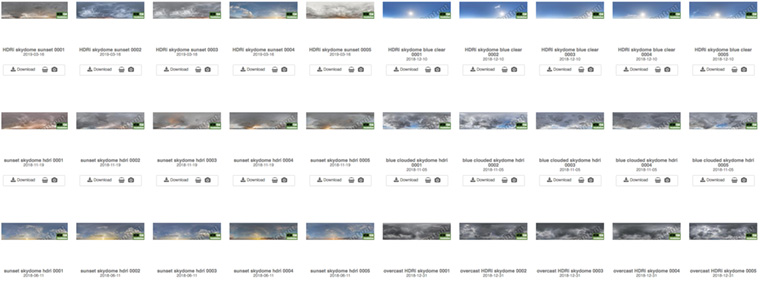
Do you want to get the best result of your renders?
You can change a sky in your 3D scene with our HDR skydomes. You can illuminate your 3D scene depending on whether you want to have a cloudy sky, clear sky or sunset sky :)
What is the HDRi texture?
High-dynamic-range imaging (HDRI) is a high dynamic range (HDR) technique used in imaging and photography to reproduce a greater dynamic range of luminosity than is possible with standard digital imaging or photographic techniques. The aim is to present a similar range of luminance to that experienced through the human visual system. The human eye, through adaptation of the iris and other methods, adjusts constantly to adapt to a broad range of luminance present in the environment. The brain continuously interprets this information so that a viewer can see in a wide range of light conditions.
Use 20% Discount for any plan on Environment-Textures.com!
Valid until 22.03. 2020
You can use our discount code HDRi_SKYDOMES_20% for your membership (3 month membership and up)
Our HDRi Skydomes are High Resolution at 7K, 12K or 15K resolution. You can find 6 kinds of category on our website.
Here are 6 categories with our HDRi Skydome textures :)
 |
|
Blue clear HDRi skydomes
|
 |
|
Blue clouded HDRi skydomes
|
 |
|
Cirrus HDRi skydomes
|
 |
|
Dusk HDRi skydomes
|
 |
|
Overcast HDRi skydomes
|
 |
| Sunset HDRi skydomes |
Or if you want here are all our skydomes in one place.
We have some HDRi textures for FREE. You can download here.
100% detail of our HDRi skydomes.
 |
 |
 |
HDR images can represent a greater range of luminance levels than can be achieved using more traditional methods, such as many real-world scenes containing very bright, direct sunlight to extreme shade, or very faint nebulae. This is often achieved by capturing and then combining several different, narrower range, exposures of the same subject matter. Non-HDR cameras take photographs with a limited exposure range, referred to as LDR, resulting in the loss of detail in highlights or shadows.
The two primary types of HDR images are computer renderings and images resulting from merging multiple low-dynamic-range (LDR) or standard-dynamic-range (SDR) photographs. HDR images can also be acquired using special image sensors, such as an oversampled binary image sensor.
Due to the limitations of printing and display contrast, the extended luminosity range of an HDR image has to be compressed to be made visible. The method of rendering an HDR image to a standard monitor or printing device is called tone mapping. This method reduces the overall contrast of an HDR image to facilitate display on devices or printouts with lower dynamic range, and can be applied to produce images with preserved local contrast (or exaggerated for artistic effect).
Tone mapping reduces the dynamic range, or contrast ratio, of an entire image while retaining localized contrast. Although it is a distinct operation, tone mapping is often applied to HDRI files by the same software package.
Comparison with traditional digital images
Information stored in high-dynamic-range images typically corresponds to the physical values of luminance or radiance that can be observed in the real world. This is different from traditional digital images, which represent colors as they should appear on a monitor or a paper print. Therefore, HDR image formats are often called scene-referred, in contrast to traditional digital images, which are device-referred or output-referred. Furthermore, traditional images are usually encoded for the human visual system (maximizing the visual information stored in the fixed number of bits), which is usually called gamma encoding or gamma correction. The values stored for HDR images are often gamma compressed (power law) or logarithmically encoded, or floating-point linear values, since fixed-point linear encodings are increasingly inefficient over higher dynamic ranges.
HDR images often don't use fixed ranges per color channel—other than traditional images—to represent many more colors over a much wider dynamic range. For that purpose, they do not use integer values to represent the single color channels (e.g., 0-255 in an 8 bit per pixel interval for red, green and blue) but instead use a floating point representation. Common are 16-bit (half precision) or 32-bit floating point numbers to represent HDR pixels. However, when the appropriate transfer function is used, HDR pixels for some applications can be represented with a color depth that has as few as 10–12 bits for luminance and 8 bits for chrominance without introducing any visible quantization artifacts.










